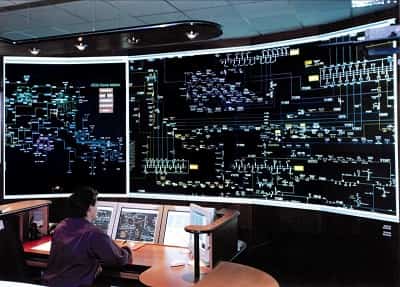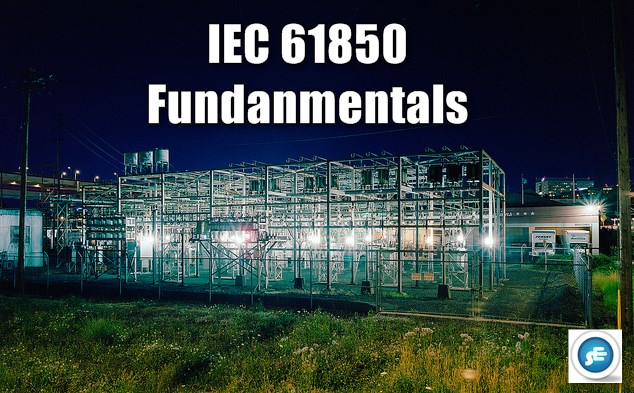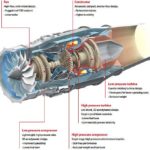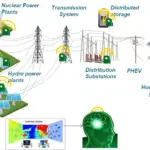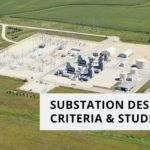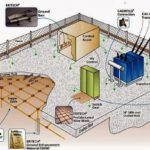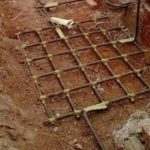What is IEC 61850?
IEC 61850 is not just a communications protocol. It is a comprehensive standard for the design of substation automation systems and applications.
- how to describe the devices in an electrical substation and
- how to exchange information about these devices
- at configuration time and
- at run-time.
IEC 61850 is the global standard for power utility automation and Smart Grids. It is a key standard to enable interoperability between equipment and systems from different manufacturers.
Read: IEC 61850 – Features and Advantages
A fully automated distribution system can make the power grid much more reliable. The IEC 61850 standard can help us get there by overcoming the key hurdle of interoperability.
IEC 61850 was developed by the International Electrotechnical Commission, Geneva by a group of manufacturers (ABB, Alstom, Schneider, SEL, Siemens, Toshiba,..) and electrical utilities (Electricité de France, Iberdrola, Hydro-Quebec,…)
Introduction to IEC 61850
Over the last decade, the “digitization” of the electron enterprise has grown at exponential rates. Utility, industrial, commercial, and even residential consumers are transforming all aspects of their lives into the digital domain.
Moving forward, it is expected that every piece of equipment, every receptacle, every switch, and even every light bulb will possess some type of setting, monitoring and/or control.
In order to be able to manage a large number of devices and to enable the various devices to communicate with one another, a new communication model was needed. That model has been developed and standardized as IEC 61850 – Communication Networks and Systems in Substations.
The IEC 61850 protocol standard for substation enables the integration of all protection, control, measurement and monitoring functions by one common protocol.
It provides the means of high-speed substation applications, station-wide interlocking and other functions which needs intercommunication between IEDs.
The well-described data modeling, the specified communication services for the most recent tasks in a station makes the standard to a key element in modern substation systems.
To understand the IEC 61850 standard and to be able to find the related information, the following parts of the standard are of importance:
- Station Configuration description Language (SCL) is described in IEC 61850-6. The SCL is an XML based definition of how to describe the parts of a substation. This part of the standard also includes the roles of different tools as well as the engineering concepts.
- Communication profile (IEC 61850 stack) is described in IEC 61850-8-1. This part of the standard includes a number of possible communication profiles, and how the services defined in IEC 61850-7-2 are mapped to the communication profile.
- Communication services are described in IEC 61850-7-2. This part deals mainly with the communication facilities from client and server point of view.
It includes the different possibilities of communication functionality. - Logical node data model. This is described in IEC 61850-7-3 and IEC 61850-7-4.
- Conformance tests and the basis for conformance documents are handled in IEC 61850-10.
Scope and Outline of IEC 61850
The stated scope of IEC 61850 was communications within the substation. The document defines the various aspects of the substation communication network in 10 major sections as shown in Table below.
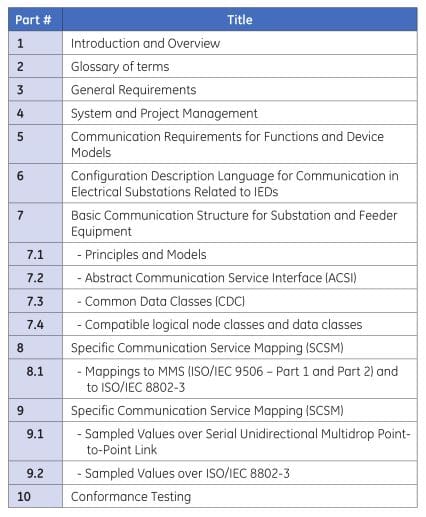
Parts 3, 4, and 5 of the standard start by identifying the general and specific functional requirements for communications in a substation (key requirements stated above).
These requirements are then used as forcing functions to aid in the identification of the services and data models needed, application protocol required, and the underlying transport, network, data link, and physical layers that will meet the overall requirements.
The major architectural construct that IEC 61850 adopts is that of “abstracting” the definition of the data items and the services, that is, creating data items/objects and services that are independent of any underlying protocols.
The abstract definitions then allow “mapping” of the data objects and services to any other protocol that can meet the data and service requirements.
The definition of the abstract services is found in part 7.2 of the standard and the abstraction of the data objects (referred to as Logical Nodes) is found in part 7.4.
In as much as many of the data objects are made up of common pieces (such as Status, Control, Measurement, Substitution), the concept of “Common Data Classes” or “CDC” was developed which defined common building blocks for creating the larger data objects. The CDC elements are defined in part 7.3.
Given the data and services abstract definitions, the final step was one of “mapping” the abstract services into an actual protocol.
Section 8.1 defines the mapping of the abstract data object and services onto the Manufacturing Messaging Specification – MMS2 and sections 9.1 and 9.2 define the mapping of the Sample Measured Values (unidirectional point-to-point and bi-directional multipoint accordingly) onto an Ethernet data frame. The 9.2 document defines what has become known as the Process Bus.
From a system perspective, there is a significant amount of configuration that is required in order to put all the pieces together and have them work.
In order to facilitate this process and to eliminate much of the human error component, an XML based Substation Configuration Language (SCL) was defined in part 6. It allows the formal description of the relations between the substation automation system and the substation (switchyard).
At the application level, the switchyard topology itself and the relation of the switchyard structure to the SAS functions (logical nodes) configured on the IEDs can be described. Each device must provide an SCL file that describes the configuration of itself.
Although the scope of IEC 61850 was originally focused “inside” the substation, discussions are underway to look at defining IEC 61850 for the Substation to Master communication protocol (already in service in several installations). In addition, applications are in service that uses various components of IEC 61850 for wide-area substation-to-substation communication.
Finally, part 10 of the document defines a testing methodology in order to determine “conformance” with the numerous protocol definitions and constraints defined in the document.
Standard Documents
- IEC 61850-1: Introduction and overview
- IEC 61850-2: Glossary
- IEC 61850-3: General requirements
- IEC 61850-4: System and project management – Ed.2
- IEC 61850-5: Communication requirements for functions and device models
- IEC 61850-6: Configuration language for communication in electrical substations related to IEDs – Ed.2
- IEC 61850-7: Basic communication structure for substation and feeder equipment
- IEC 61850-7-1: Principles and models – Ed.2
- IEC 61850-7-2: Abstract communication service interface (ACSI) – Ed.2
- IEC 61850-7-3: Common Data Classes – Ed.2
- IEC 61850-7-4: Compatible logical node classes and data classes – Ed.2
- IEC 61850-7-10: Communication networks and systems in power utility automation – Requirements for web-based and structured access to the IEC 61850 information models [Approved new work]
- IEC 61850-8: Specific communication service mapping (SCSM)
- IEC 61850-8-1: Mappings to MMS (ISO/IEC9506-1 and ISO/IEC 9506-2) – Ed.2
- IEC 61850-9: Specific communication service mapping (SCSM)
- IEC 61850-9-1: Sampled values over serial unidirectional multidrop point to point link
- IEC 61850-9-2: Sampled values over ISO/IEC 802-3 – Ed.2
- IEC 61850-10: Conformance testing
